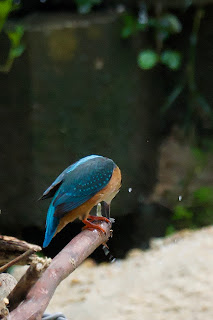Passeriformes - Motacillidae - Motacilla cinerea (Kedidi-Air Kelabu)
Handsome long-tailed bird. Breeding male has a black throat, mostly yellow underparts. Breeding female often has some dark on the throat, paler yellow underparts. All plumages have gray head and back, with whitish eyebrow, bright yellow belly and vent. Often near flowing water with nearby rocks or surrogate rocky habitat, from mountain streams to weirs in suburban parklands. Walks quietly along shorelines or in nearby open areas, pumping its very long, white-sided tail up and down. Song is a repetitive series of high-pitched notes; calls include short, high “pseet” and buzzier flight calls.
(eBird)
Is fear synonymous with flight?
Fear always looks backward.
* Loathing shame - No favour accepted, no disgrace to bear
- Avoid owing, therefore no obligation, no guilt -

























































